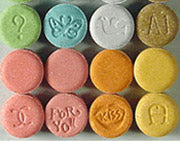Drug Profiles
Street Drugs (Illicit)
 |
MARIJUANA THC THC (∆9-tetrahydrocannabinol) is the primary active ingredient in cannabis (marijuana). When smoked or orally administered. Effects THC produces euphoric effects. Users have impaired short term memory and slowed learning. They may also experience transient episodes of confusion and anxiety. Long-term, heavy use may be associated with behavioural disorders. The peak effect of marijuana administered by smoking usually occurs in 20-30 minutes and the duration is between approximately 90-120 minutes after one cigarette. Detection Elevated levels of urinary metabolites are found within hours of exposure and remain detectable for between 3-10 days after smoking. The main metabolite excreted in the urine is 11-nor-∆9-tetrahydrocannabinol-9-carboxylic acid (∆9-THC-COOH). |
 |
COCAINE (COC) Cocaine is a potent central nervous system (CNS) stimulant and a local anaesthetic. Cocaine is often self-administered by nasal inhalation, intravenous injection and free-base smoking. Effects Initially, it usually brings about extreme energy and restlessness while gradually resulting in tremors, over-sensitivity and spasms. In large amounts, cocaine may cause fever, unresponsiveness, difficulty in breathing and unconsciousness. Detection It is excreted in the urine in a short time primarily as Benzoylecgonine. Benzoylecgonine, a major metabolite of cocaine, has a longer biological half-life (5-8 hours) than cocaine (0.5-1.5 hours), and can generally be detected for 24-48 hours after cocaine exposure. |
 |
OPIATES OPI (OPIUM & HEROIN) Opioids are a wide group of drugs that include both illicit drugs and prescription medications. Different opioids have different effects, uses, safety, and legality. Heroin is a highly addictive drug derived from morphine, which is obtained from the opium poppy. In Australia, heroin can be a fine powder, granules or rocks. It is normally white or off-white in colour, although it is sometimes brown. It is normally injected, but is also snorted, smoked, or heated and the vapours inhaled (chasing the dragon). It can be sold ‘cut’ (mixed) with a range of substances that can also be harmful. This makes it hard for the user to know the purity of what’s being taken. Effects Opium can cause euphoria, followed by a sense of well-being and a calm drowsiness or sedation. Breathing slows, potentially to the point of unconsciousness and death with large doses. Other effects can include nausea, confusion and constipation. Use of opium with other substances that depress the central nervous system, such as alcohol, antihistamines, barbiturates, benzodiazepines, or general anaesthetics, increases the risk of life-threatening respiratory depression. Detection The window of detection for Opiates is typically within 1-2 days of substance use. This can vary depending on specific substance type. |
 |
AMPHETAMINE AMP (Speed) Amphetamine is a Schedule II controlled substance available by prescription and is also available on the illicit market. Amphetamines are a class of potent sympathomimetic agents with therapeutic applications. They are chemically related to the human body’s natural catecholamines: epinephrine and norepinephrine. Effects Acute higher doses may lead to enhanced stimulation of the central nervous system and induce euphoria, alertness, reduced appetite, and a sense of increased energy and power. Cardiovascular responses to Amphetamines can include increased blood pressure and cardiac arrhythmias. More acute responses may produce anxiety, paranoia, hallucinations, and psychotic behaviour. The effects of Amphetamines generally last 2-4 hours following use and the drug has a half-life of 4-24 hours in the body. Detection About 30% of Amphetamines are excreted in the urine in unchanged form, with the remainder as hydroxylated and deaminated derivatives. |
 |
METHAMPHETAMINE MET (CRYSTAL) Methamphetamine is made in illegal laboratories and has a high potential for abuse and dependence. The drug can be taken orally, injected, or inhaled. Effects Methamphetamine is an addictive stimulant drug that strongly activates certain systems in the brain. Methamphetamine is closely related chemically to amphetamine, but the central nervous system effects of Methamphetamine are generally greater. Acute higher doses may lead to enhanced stimulation of the central nervous system and induce euphoria, alertness, reduced appetite, and a sense of increased energy and power. Cardiovascular responses to Methamphetamine can include increased blood pressure and cardiac arrhythmias. More acute responses produce anxiety, paranoia, hallucinations, psychotic behaviour, and eventually, depression and exhaustion. The effects of Methamphetamine generally last 2-4 hours and the drug has a half-life of 9-24 hours in the body. Detection Methamphetamine is excreted in the urine as amphetamine and oxidised and deaminated derivatives. However, 10-20% of Methamphetamine is excreted unchanged. Thus, the presence of the parent compound in the urine indicates Methamphetamine use. Methamphetamine is generally detectable in the urine for 3-5 days, depending on urine pH level. |
 |
Methylenedioxy-methamphetamine MDMA (Ecstasy) MDMA (Methylenedioxy-methamphetamine) is commonly known as Ecstasy. It is an illicit stimulant drug that causes extreme levels of dopamine to be released. MDMA (Ecstasy) is often consumed in pill form but can also come as crystal or powder. Effects MDMA (Ecstasy) is commonly used to generate a sense of euphoria. Excessive consumption can result in a floating sensation and can cause the user the hallucinate. Common visible physical side effects include teeth grinding, enlarged pupils, sweating and vomiting. Detection The window of detection for MDMA (Ecstasy) is typically within 2-4 days of substance use. |
Prescription Drugs
 |
TRICYCLIC TCA (ANTI-DEPRESSANTS) TCA (Tricyclic Antidepressants) are commonly used for the treatment of depressive disorders. Effects TCA overdoses can result in profound central nervous system depression, cardiotoxicity and anticholinergic effects. TCA overdose is a common cause of death from prescription drugs. TCAs are taken orally or sometimes by injection. TCAs are metabolised in the liver. Detection Both TCAs and their metabolites are excreted in urine mostly in the form of metabolites for up to ten days. |
 |
BARBITURATES BAR Barbiturates are central nervous system depressants. They are used therapeutically as sedatives, hypnotics, and anticonvulsants. Barbiturates are almost always taken orally as capsules or tablets. Effects The effects resemble those of intoxication with alcohol. Chronic use of barbiturates leads to tolerance and physical dependence. Short acting Barbiturates taken at 400 mg/day for 2-3 months can produce a clinically significant degree of physical dependence. Withdrawal symptoms experienced during periods of drug abstinence can be severe enough to cause death. Only a small amount (less than 5%) of most Barbiturates are excreted unaltered in the urine. Detection The approximate detection time limits for Barbiturates are:
|
 |
BENZODIAZEPINES BZO Benzodiazepines are medications that are frequently prescribed for the symptomatic treatment of anxiety and sleep disorders. . Benzodiazepines are also used as sedatives before some surgical and medical procedures, and for the treatment of seizure disorders and alcohol withdrawal. Effects They produce their effects via specific receptors involving a neurochemical called gamma aminobutyric acid (GABA). Because they are safer and more effective, Benzodiazepines have replaced barbiturates in the treatment of both anxiety and insomnia. Risk of physical dependence increases if Benzodiazepines are taken regularly (e.g., daily) for more than a few months, especially at higher than normal doses. Stopping abruptly can bring on such symptoms as trouble sleeping, gastrointestinal upset, feeling unwell, loss of appetite, sweating, trembling, weakness, anxiety and changes in perception. Only trace amounts (less than 1%) of most Benzodiazepines are excreted unaltered in the urine. Most of the concentration in urine is conjugated drug. Detection The detection period for the Benzodiazepines in the urine is 3-7 days. |
 |
METHADONE MTD Methadone is a narcotic analgesic prescribed for the management of moderate to severe pain and for the treatment of opiate dependence (heroin, Vicodin, Percocet, Morphine). The pharmacology of Oral Methadone is very different from IV Methadone. Oral Methadone is partially stored in the liver for later use. IV Methadone acts more like heroin. Effects Methadone is a long acting pain reliever producing effects that last from 12-48 hours. Ideally, Methadone frees the client from the pressures of obtaining illegal heroin, from the dangers of injection, and from the emotional roller coaster that most opiates produce. However, Methadone, if taken for long periods and at large doses, can lead to a very long withdrawal period. The withdrawals from Methadone are more prolonged and troublesome than those provoked by heroin cessation, yet the substitution and phased removal of methadone is an acceptable method of detoxification for patients and therapists. Detection The detection period for Methadone is in the Urine is up to 12 days, and up to 10 days in Saliva. |

